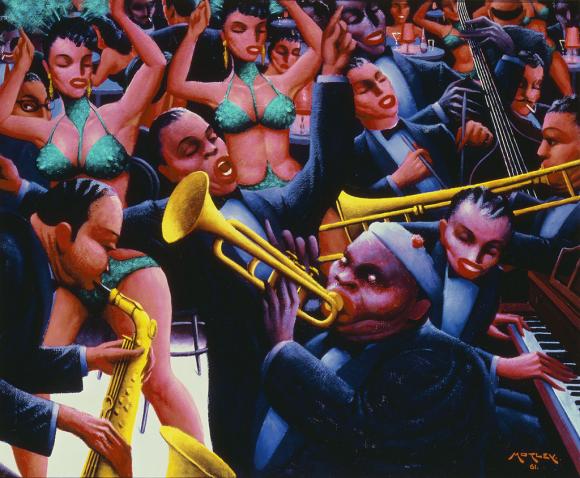10 Must See Dallas Summer Exhibitions

Archibald J. Motley Jr. (1891–1981) Hot Rhythm, 1961 Oil on canvas © Valerie Gerrard Browne Collection of Mara Motley, MD, and Valerie Gerrard Browne Image courtesy of the Chicago History Museum, Chicago, Illinois
DFW museums are not messing around this summer. Art lovers can expect to see world-class works from around the globe. From twelfth-century Japanese armor to eighteenth-century French drawings, there’s truly something for everyone to enjoy this summer. Don’t forget to check out the extended viewing hours that most institutions promote heavily this time of year offering discounted tickets, drinks and live entertainment. Here are my picks for the 10 must see DFW summer exhibitions.
1. Archibald Motley: Jazz Age Modernist–Amon Carter Museum of American Art
June 14–September 7, 2014

Archibald J. Motley Jr. (1891–1981) Mending Socks, 1924 Oil on canvas © Valerie Gerrard Browne Collection of the Ackland Art Museum, The University of North Carolina at Chapel Hill, Burton Emmett Collection
Archibald Motley: Jazz Age Modernist is the first retrospective of the American artist’s paintings in two decades. Archibald John Motley Jr. (1891–1981) is one of the most significant yet least known twentieth-century artists, despite the continued broad appeal of his paintings. Many of his most important portraits and cultural scenes remain in private collections and few museums have had the opportunity to acquire his work. In a survey that spans forty years, Archibald Motley includes forty-three works spanning each period of Motley’s career, from 1919 to 1960. Motley’s scenes of life in an African-American community, often in his native Chicago, depict a parallel existence of labor and leisure. His portraits are voyeuristic, but they are also examinations of race, gender and sexuality. Motley did not shy away from folklore fantasies, directly addressing slavery and racism. The exhibition also features his noteworthy depictions of Jazz Age Paris and 1950s Mexico.
2. Mark Grotjahn Sculpture–Nasher Sculpture Center
May 31–August 17, 2014

Mark Grotjahn, Untitled (TBD Mask gated M24.c), 2012–13 Painted bronze, 94 x 41 1/2 x 48 1/2 in. (238.8 x 105.4 x 123.2 cm) Courtesy Mark Grotjahn © Mark Grotjahn
Los Angeles-based artist Mark Grotjahn came to prominence for large, richly worked paintings that evoke aspects of contemporary discourse. In two different series—the Face and the Butterfly paintings—Grotjahn used essential subjects to explore textures, colors and form with refreshing boldness and almost hallucinogenic intensity. Alongside his paintings, Grotjahn has been working privately on sculpture for over a decade. The Nasher’s exhibition, the first presentation of Grotjahn’s sculpture in a museum, highlights many new, never-before-seen, three-dimensional works.
3. Shen Wei–Crow Collection of Asian Art
June 14–September 29, 2014

Shen Wei, Crow Collection of Asian Art, Dallas, Texas
In the significant recent series of paintings featured in Shen Wei, the artist narrows his focus to a study of the grisaille palette and the expressive textures of oil paint. These compositions in black, white and gray are shrouded in an aura of mystery. The shapes and textures can, in places, appear to resemble elements of a sublime landscape—jagged rocks, rushing water, imposing clouds and elusive figures and animals. They have a dreamlike quality reminiscent of surrealist explorations of the unconscious that melds, unexpectedly, with visible brushstrokes and the traces of swift, decisive action. Meditations on landscape, the subtly beautiful and the strange have long been the domain of literati artists in China. Shen Wei, with this new series, takes these meditations to new heights and profound depths.
4. The Museum is History–Dallas Museum of Art
May 24–November 16, 2014

Richard Diebenkorn, Ocean Park No. 29, 1970, oil on canvas, Dallas Museum of Art, gift of the Meadows Foundation, Incorporated © Estate of Richard Diebenkorn
The Museum Is History is drawn from the DMA’s holdings of modern and contemporary art, as well as from local collections. The works on view in The Museum Is History roughly span the years 1950 to 1990. Beginning with gestural abstraction, the exhibition turns to those artists who rethought the role of art making and embraced a reductive vocabulary with elegant symmetry. The display concludes with a number of artists from the 1980s who delved even further into an exploration of the human condition by combining minimal traditions with emotive content.
5. No Place Like Home: American Scene Painting in the Sinquefield Collection–Amon Carter Museum of American Art
Through October 19, 2014

Thomas Hart Benton (1889–1975) Self Portrait, 1924–25 Oil on canvas Art © Benton Testamentary Trusts/UMB Bank Trustee/Licensed by VAGA, New York, NY Collection of Jeanne and Rex Sinquefield
No Place Like Home: American Scene Painting in the Sinquefield Collection features a selection of twenty paintings from the private collection of Jeanne and Rex Sinquefield, a St. Louis couple devoted to art of the American Midwest made between the World Wars. With distinctive tastes and discerning eyes, the Sinquefields have built an extraordinary collection that conveys the importance of this region in the national story of American art. The exhibition includes work by the famed regionalists Thomas Hart Benton, John Steuart Curry and Grant Wood, as well as paintings by John Atherton, Joe Jones and John Rogers Cox, who like their more celebrated colleagues, interpreted the reality of the heartland with passion, vigor and poignancy.
6. Samurai: Armor from the Ann and Gabriel Barbier-Mueller Collection–Kimbell Art Museum
Through August 31, 2014

Armor of the Åyoroi type (Åyoroi tÅsei gusoku) Mid-Edo period, late 18th century Iron, leather, gold, bronze, copper 56 x 22 ½ x 23 in. (142.24 x 57.15 x 58.42 cm)
Travel back in time and discover the Japanese samurai warriors through more than 140 remarkable objects from one of the best and largest collections in the world. Samurai features the extraordinary artistry of the armor used by samurai—the military elite led by the shoguns, or warlords, of Japan from the 12th through 19th centuries. The exhibition illustrates the evolution of the distinctive appearance and equipment of the samurai through the centuries and examines the warriors’ history through works of consummate craftsmanship and exquisite design. Combat-ready samurai in full regalia is shown in suits of intricately crafted armor on similarly armored steeds. The exhibition also includes beautifully designed accoutrements used for both battle and ceremonies.
7. June Wayne: The Tamarind Decade–Amon Carter Museum of American Art
Through July 6, 2014

June Wayne (1918–2011) To Get to the Other Side, 1967 Lithograph © 1965 June Wayne Amon Carter Museum of American Art, Fort Worth, Texas
June Wayne: The Tamarind Decade features approximately fifteen works created during her oversight of the Tamarind Lithography Workshop, including prints in various states or versions that communicate how the artist reworked themes in different iterations. This exhibition offers a glimpse into the work of the artist behind the influential workshop, whose vision ensured that the practice of lithography is alive and thriving today.
8. Mind’s Eye: Masterworks on Paper from David to Cézanne–Dallas Museum of Art
June 29–October 26, 2014

Paul Cezanne, Still Life with Apples on a Sideboard, 1900-1906, Watercolor, Dallas Museum of Art, The Wendy and Emery Reves Collection
From quick sketches to watercolors, works by artists such as Edgar Degas, Paul Cézanne, Vincent van Gogh, Edouard Manet, Jacques-Louis David, Théodore Géricault and Eugène Delacroix are brought together in the exhibition Mind’s Eye: Masterworks on Paper from David to Cézanne. Drawn from the DMA’s collection, as well as from several private collections, the exhibition features more than 100 works on paper, many of which are rarely on view, in various media by 70 artists. Mind’s Eye offers new insights into the working methods and practices of these artists, providing an intimate view of their approach to art making while also presenting the drawings and watercolors as finished works of art in their own right.
9. Seeing and Believing: Krishna in the Art of B. G. Sharma–Crow Collection of Asian Art
July 19, 2014–January 19, 2015

Seeing and Believing: Krishna in the Art of B. G. Sharma Crow Collection of Asian Art, Dallas, Texas Sri Sri Radha Kalachandji Mandir Hare Krishna Temple is a community partner of this exhibition.
Seeing and Believing: Krishna in the Art of B. G. Sharma proposes that visitors set aside habits of viewing that resist sweetness with labels such as “kitsch,†or dismiss pictures that tug at sentiment as invasive. The twenty Sharma paintings included in Seeing and Believing rest on ethics of long cultivation and refinement, and address a sense of awareness with a sophisticated understanding of human nature. The works seduce the viewer with friendly but frank eroticism. This approach to Sharma’s work is guided in this exhibition through texts that accompany each image and are drawn from the rich literature—puranas, poetry, songs and prayers—sustaining Krishna worship in many languages.
10. The Spanish Gesture: Drawings from Murillo to Goya in the Hamburger Kunsthalle–Meadows Museums
May 25–August 31, 2014

Bartolome Esteban Murillo (1617-1682), Assumption of the Virgin, 1665-70. Pen and brown ink, brown wash over black chalk. Hamburger Kunsthalle, Kupferstichkabinett. Photo by Christoph Irrgang.
The Kunsthalle of Hamburg holds one of the most significant collections of Spanish drawings found outside of Spain, containing works by Alonso Cano, Bartolomé Esteban Murillo, Juan de Valdés Leal and Francisco de Goya y Lucientes, among others. This is the first exhibition to present the exquisite collection on a large scale, 123 years after they were purchased. As part of the continued collaboration between the Meadows Museum and the Museo Nacional del Prado, the jointly organized exhibition presents 80 drawings, first in Dallas, then in Madrid.







